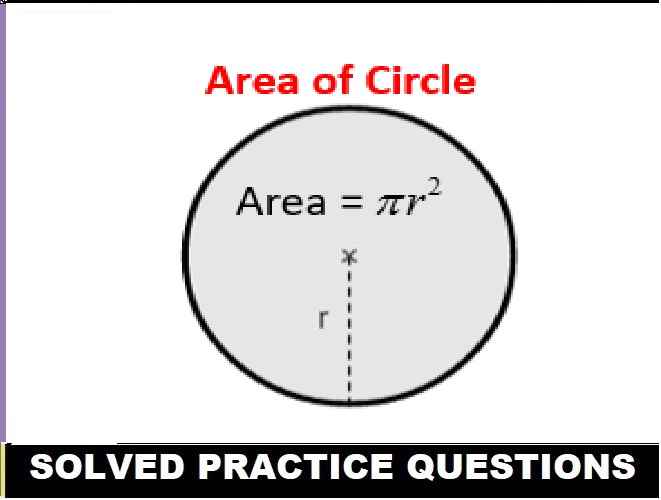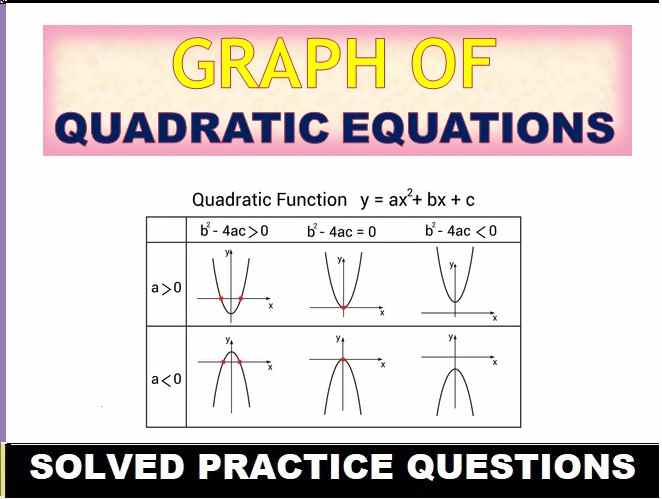ML Aggarwal Quadrilaterals Shapes MCQs Class 8 ICSE Ch-13 Maths Solutions. We Provide Step by Step Answer of MCQs Questions for Quadrilaterals Shapes as council prescribe guideline for upcoming board exam. Visit official Website CISCE for detail information about ICSE Board Class-8.
ML Aggarwal Quadrilaterals Shapes MCQs Class 8 ICSE Maths Solutions
| Board | ICSE |
| Publications | Avichal Publishig Company (APC) |
| Subject | Maths |
| Class | 8th |
| Chapter-13 | Quadrilaterals Shapes |
| Writer | ML Aggarwal |
| Book Name | Understanding |
| Topics | Solution of MCQs |
| Edition | 2023-2024 |
Quadrilaterals Shapes MCQs
ML Aggarwal Class 8 ICSE Maths Solutions
Page-245
Mental Maths
Question 1. Fill in the blanks:
(i) The curves which have different beginning and end points are called …………
(ii) A curve which does not cross itself at any point is called a …………
(iii) A simple closed curve made up entirely of line segments is called a …………
(iv) A polygon in which each interior angle is less than 180° is called a …………
(v) 10 sided polygon is called …..
(vi) A polygon which has all its sides of equal length and all its angles of equal measure is called a …………
(vii) Sum of all exterior angles of a polygon is …………
(vi) A polygon which has all its sides of equal length and all its angles of equal measure is called a …………
(vii) Sum of all exterior angles of a polygon is …………
(viii) Sum of all interior angles of a n-sided polygon is …………
(ix) The adjacent angles of a parallelogram are …………
(x) If an angle of a parallelogram is a right angle, then it is called a …………
(xi) If two adjacent sides of a parallelogram are equal, then it is called a …………
(xii) It two adjacent sides of a rectangle are equal, then it is called a …………
(xiii) The diagonal of a rhombus bisect each other at …………
(xiv) A quadrilateral in which one pair of opposite sides is parallel is called a …………
(xv) A quadrilateral in which two pairs of adjacent sides are equal is called a …………
(xvi) If two non-parallel sides of a trapezium are equal then it is called …………
Answer:
(i) The curves which have different beginning and end points are called open curves.
(ii) A curve which does not cross itself at any point is called a simple curve.
(iii) A simple closed curve made up entirely of line segments is called a polygon.
(iv) A polygon in which each interior angle is less than 180° is called a convex polygon.
(v) 10 sided polygon is called decagon.
(vi) A polygon which has all its sides of equal length and all its angles of equal measure is called a regular polygon.
(vii) Sum of all exterior angles of a polygon is 360°.
(viii) Sum of all interior angles of a n-sided polygon is (n – 2) × 180° or (2n – 4) × 90°.
(ix) The adjacent angles of a parallelogram are supplementary.
(x) If an angle of a parallelogram is a right angle, then it is called a rectangle.
(xi) If two adjacent sides of a parallelogram are equal, then it is called a rhombus.
(xii) It two adjacent sides of a rectangle are equal, then it is called a square.
(xiii) The diagonal of a rhombus bisect each other at right angles.
(xiv) A quadrilateral in which one pair of opposite sides is parallel is called a trapezium.
(xv) A quadrilateral in which two pairs of adjacent sides are equal is called a kite.
(xvi) If two non-parallel sides of a trapezium are equal then it is called an isosceles trapezium.
Question 2. State whether the following statements are true (T) or false (F):
(i) The curves which have same beginning and end points are called open curves.
(ii) The region of the plane that lies inside the curve is called interior of curve.
(iii) A polygon in which atleast one interior angle is greater than 180° is called convex polygon.
(iv) 6 sided polygon is called hexagon.
(v) Sum of all interior angles of a quadrilateral is 180°.
(vi) Each interior angle of a n-sided regular polygon is (2n-4) x 90º/n.
(vii) The diagonals of a parallelogram bisect each other at right angles.
(viii) The opposite angles of a parallelogram are of equal measure.
(ix) The diagonals of a rhombus bisect the angles of rhombus.
(x) The diagonals of a square are not equal.
(xi) Co-interior angles of a parallelogram are supplementary.
(xii) The diagonals of a kite bisect at right angles.
(xiii) All rectangles are squares.
(xiv) All rhombuses are parallelograms.
(xv) All squares are rhombuses and also rectangles.
(xvi) All squares are not parallelograms.
(xvii) All kites are rhombuses.
(xviii) All rhombuses are kites.
(xix) All parallelograms are trapeziums.
(xx) All squares are trapeziums.
Answer:
(i) The curves which have same beginning and end points are called open curves. False
(ii) The region of the plane that lies inside the curve is called interior of curve. True
(iii) A polygon in which atleast one interior angle is greater than 180° is called convex polygon. False
(iv) 6 sided polygon is called hexagon. True
(v) Sum of all interior angles of a quadrilateral is 180°. False
(vi) Each interior angle of a n-sided regular polygon is (2n-4) x 90º/n. True
(vii) The diagonals of a parallelogram bisect each other at right angles. False
(viii)The opposite angles of a parallelogram are of equal measure. True
(ix) The diagonals of a rhombus bisect the angles of rhombus. True
(x) The diagonals of a square are not equal. False
(xi) Co-interior angles of a parallelogram are supplementary. True
(xii) The diagonals of a kite bisect at right angles. False
(xiii) All rectangles are squares. False
(xiv) All rhombuses are parallelograms. True
(xv) All squares are rhombuses and also rectangles. True
(xvi) All squares are not parallelograms. False
(xvii) All kites are rhombuses. False
(xviii) All rhombuses are kites. True
(xix) All parallelograms are trapeziums. True
(xx) All squares are trapeziums. True
Quadrilaterals Shapes MCQs
ML Aggarwal Class 8 ICSE Maths Solutions
Page-246
Choose the correct answer from the given four options (3 to 19):
Question 3. Sum of all interior angles of a 11-sided polygon is
(a) 1620°
(b) 1440°
(c) 1260
(d) none of these
Answer:
Sum of all interior angles of an 11-sided polygon is
= (2 × n – 4 ) × 90°
= (2 × 11 – 4) × 90°
= 18 × 90 = 1620 (a
Question 4. If each interior angle of a regular polygon is 144°, then number of sides of polygon is
(a) 8
(b) 9
(c) 10
(d) 11
Answer:
Each interior angle of a regular polygon is 144°
Then 2n-4/n × 90° = 144°
⇒ 2n-4/n = 144°/90°
⇒ 10n – 20° = 8n
⇒ 10n – 8n = 20°
⇒ 2n = 20°
⇒ n = 10
∴ It is 10-sided polygon. (c)
Question 5. If the sum of all interior angles of a polygon is 1260°, then number of sides of polygon is
(a) 6
(b) 7
(c) 8
(d) 9
Answer
Sum of all interior angles of a polygon = 1260°
∴ (2n – 4) × 90° = 1260°
⇒ 2n – 4 =1260°/90°
⇒ 2n = 14 + 4 = 18
⇒ n = 18/2 = 9
∴ Polygon is 9-sided. (d)
(ML Aggarwal Quadrilaterals Shapes MCQs Class 8 ICSE Maths)
Question 6. The sum of all exterior angles of a pentagon is
(a) 590°
(b) 360°
(c) 180°
(d) none of these
Answer:
Sum of exterior angles of a pentagon = 360° (b)
Question 7. If the ratio between an exterior and interior angle of a regular polygon is 1 : 5, then the number of sides of the polygon is
(a) 11
(b) 12
(c) 13
(d) 14
Answer:
Ratio between exterior angle and interior angle
of a regular polygon = 1 : 5
But sum of angles = 180°
∴ Exterior angle = 180°/(1+5) × 1
= 180°/6 = 30°
∴ Number of sides = 360°/30 =12 (b)
(Sum of exterior angles = 360°)
Question 8. In the given figure, the value of x is
(a) 140°
(b) 50°
(c) 130°
(d) 40°

Answer:
In the given figure,
Sum of exterior angles of a triangle = 360°
∴ 140° + x + 90° = 360°
⇒ x + 230° = 360°
∴ x = 360° – 230° = 130° (c)
Question 9. In the given figure, the value of x is
(a) 120°
(b) 130°
(c) 140°
(d) 150°

Answer:
In the given figure,
Sum of angles of a quadrilateral = 360°
∴ 60° + (180° – 120°) + 110° + x = 360°
⇒ 60° + 60° + 110° + x = 360°
230° + x = 360°
∴ x = 360°- 230° = 130° (b)
Question 10. In the given figure, the value of x + y + z + w is
(a) 180°
(b) 270°
(c) 300°
(d) 360°
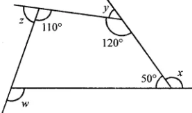
Answer:
In the given figure,
Sum of exterior angles of a quadrilateral = 360°
∴ x + y + z + w = 360° (d)
Quadrilaterals Shapes MCQs
ML Aggarwal Class 8 ICSE Maths Solutions
Page-247
Question 11. In the given figure, the value of x + y is
(a) 180°
(b) 190°
(c) 170°
(d) 160°

Answer:
In the given figure,
Sum of interior angles of a quadrilateral = 360°
60° + y + 110° + x = 360°
⇒ x + y + 170° = 360°
⇒ x + y = 360° – 170°
x + y = 190° (b)
Question 12. The lengths of two adjacent sides of a parallelogram are in the ratio 1 : 2. If the perimeter of parallelogram is 60 cm, then length of its sides are
(a) 6 cm, 12 cm
(b) 8 cm, 16 cm
(c) 9 cm, 18 cm
(d) 10 cm, 20 cm
Answer:
Ratio in the length of two adjacent sides of a parallelogram = 1 : 2
Perimeter = 60 cm
∴ Sum of two adjacent sides = 60/2 = 30 cm
Let first side = x, then second side = 2x
∴ x + 2x = 30 ⇒ 3x = 30
x = 30/2 = 10 cm
First side = 10 cm
and second side = 10 × 2 = 20 cm (d)
(ML Aggarwal Quadrilaterals Shapes MCQs Class 8 ICSE Maths)
Question 13. In the given figure, ABCD is a parallelogram, the values of x and y respectively are
(a) 1 cm, 1 cm
(b) 2 cm, 1 cm
(c) 1 cm, 2 cm
(d) 2 cm, 2 cm
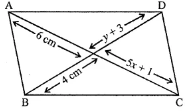
Answer:
In the given figure, ABCD is a parallelogram
∵ Diagonals of a parallelogram bisect each other
∴ AO = OC and BO = OD
∴ 6 = 5x + 1
⇒ 5x = 6 – 1 = 5
⇒ x = 5/5
and y + 3 = 4
⇒ y = 4 – 3 = 1
∴ x = 1, y = 4 (a)
Question 14. In the given figure, ABCD is a parallelogram, the values of x, y and z respectively are
(a) 60°, 60°, 70°
(b) 60°, 70°, 60°
(c) 70°, 60°, 60°
(d) none of these
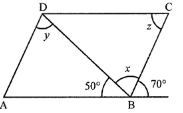
Answer:
In the given figure,

ABCD is a parallelogram, BD is its one diagonal
∠ABD + ∠DBC +∠CBE = 180°
(Angles on one side of a line)
⇒ 50° + x + 70° = 180°
x + 120° = 180°
∴ x = 180° – 120° = 60°
But y = x (Alternate angles)
∴ y = 60°
z = 70° (Alternate angles)
∴ x = 60°, y = 60°, z = 70° (a)
(ML Aggarwal Quadrilaterals Shapes MCQs Class 8 ICSE Maths)
Question 15. In the given figure, ABCD is a rectangle, the value of angle x is
(a) 60°
(b) 90°
(c) 120°
(d) none of these
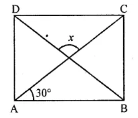
Answer:
In the given figure, ABCD is a rectangle

∴ ∠OBA = ∠OAB = 30°
In ∆AOB,
∠AOB = ∠COD (Vertically opposite angles)
∠AOB = x
∠AOB + ∠OBA + ∠OAB = 180° (Angles of a triangle)
⇒ x + 30° + 30° = 180°
⇒ x = 180°- 30°- 30° = 120°
∴ x = 120° (c)
Question 16. In a rhombus ABCD, the diagonals AC and BD are respectively 8 cm and 6 cm. The length of each side of the rhombus is
(a) 7 cm
(b) 5 cm
(c) 6 cm
(d) 8 cm
Answer: Each side of rhombus = 5 cm (b)
Question 17. In the given figure, ABCD is a square, the value of angle x is
(a) 30°
(b) 45°
(c) 60°
(d) not possible to find
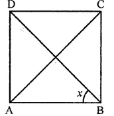
Answer: ∴ x = 1/2 × ∠B = 1/2× 90° = 45° (b)
Question 18. In the given figure, ABCD is a kite, the value of angle x is
(a) 86°
(b) 100°
(c) 104°
(d) none of these
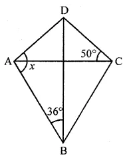
Answer:
In the given figure, ABCD is a kite whose
diagonals AC and BD intersect at O at right angles.

In ∆OAB, ∠O = 90°
∴ ∠OAB + ∠ABO = 90°
⇒ ∠OAB + 36° = 90°
⇒ ∠OAB = 90° – 36° = 54°
But ∠OAD = ∠OCD = 50°
x = ∠DAO + ∠AOB
⇒ x = 50° + 54°= 104° (c)
(ML Aggarwal Quadrilaterals Shapes MCQs Class 8 ICSE Maths)
Question 19. In the given figure, ABCD is an isosceles trapezium. The values of x, y and z respectively are
(a) 110°, 110°, 70°
(b) 110°, 70°, 110°
(c) 70°, 110°, 110°
(d) none of these

Answer:
In isosceles trapezium ∠A = 70°
But ∠B = ∠A = 70° ⇒ z = 70°
But x + 70° = 180°
⇒ x = 180°-70°= 110°
But y = x = 110°
∴ 110°, 110°, 70° (a)
Quadrilaterals Shapes MCQs
ML Aggarwal Class 8 ICSE Maths Solutions
Page-248
Question 1. In the given figure, ABCDEF is a regular hexagon. Prove that quadrialterals ABDE and ACDF are parallelograms. Also prove that quadrilateral AGDH is a parallelogram.
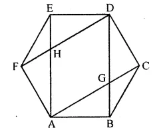
Answer:
In the given figure, ABCDEF is a regular hexagon.
AC, AE, DF, DB are joined.

To prove: ABDE, ACDF and AGDH are ||gm
Proof: In ∆BCD,
BC = CD
∴ ∠CBD = ∠CDB = 30° (∵ ∠C = 120° angle of hexagon)
But ∠B = ∠D (Angles of a regular hexagon)
∴ ∠B – ∠CBD = ∠D – ∠CDB
⇒ ∠ABD = ∠BDE = 90°
Similarly, ∠FAB = ∠AED = 90°
∴ ∠ABD + ∠BDE = 90° + 90° = 180°
But they are cointerior angle.
∴ AB || DE
∴ ABDE is a ||gm
Similarly we can prove that ACDF is a parallelogram.
∵ AC || DF and BD || AC
∴ AGDH is a parallelogram.
Question 2. In the given figure, ABCD is a parallelogram and M, N are the mid-points of sides BC, AD respectively. Prove that EA = AB = BF.
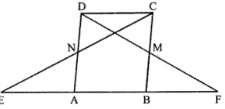
Answer:
In the given figure,
ABCD is a parallelogram M and N are
midpoints of the sides BC and AD respectively.
To prove : EA = AB = BF.
Proof: In ∆AFD,
M is the midpoint of BC and BC || AD
∴ B is mid-point of AF
∴ AB = BF …(i)
Similarly in ∆EBC,
N is the midpoint of AD and AD || BC
∴ A is the midpoint of EB
∴ EA = AB …(ii)
From (i) and (ii),
EA = AB = BF
Question 3. Prove that the quadrilateral formed by joining the mid-points of the adjacent sides of a rectangle is a parallelogram.
Answer:
Given : ABCD is a rectangle.
P, Q, R and S are the mid points of the sides
AB, BC, CD and DA respectively.
PQ, QR, RS and SP are joined.
To prove : PQRS is a parallelogram.
Construction : Join AC and BD.
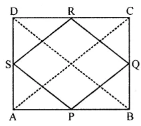
Proof: In ∆ABC,
P and Q are mid points of AB and BC respectively
∴ PQ || AC and PQ = 1/2 AC …(i)
Similarly in ∆ADC
SR mid points of AD and CD respectively
∴ SR || AC and SR = 1/2 AC …(ii)
From (i) and (ii),
SR || PQ and SR = PQ
∴ PQRS is a parallelogram.
— End of Quadrilaterals Shapes MCQs Class 8 ICSE Maths Solutions :–
Return to : – ML Aggarwal Maths Solutions for ICSE Class -8
Thanks
